
ContectIA: UC Chile and Microsoft Join Forces to Boost the Adoption of AI in Chile
19 July 2024
The initiative aims to contribute to the digital transformation and development of AI technology, which will impact Chile and Latin America. ConectIA was recently introduced to the university community alongside the AcademiaIA platform, which offers 175 learning resources, as well as information on events and tools focused on the application and development of AI.
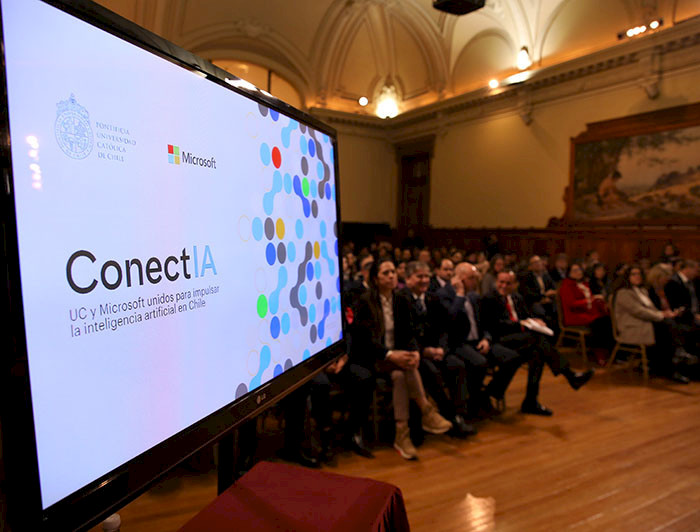
photo_camera Digital transformation is one of the main axes of the UC Development Plan for 2020-2025. (Photo: Photo by Karina Fuenzalida, Office of the Vice President for Communication & Cultural Outreach.)
UC Chile and Microsoft have partnered to launch ConectIA, an initiative aimed at promoting artificial intelligence (AI) in Chile and Latin America.
During a presentation at the UC Chille Hall of Honor in downtown Santiago, the capital city of Chile, the progress that has been made thus far on the project was shared with the university community. AcademiaIA, a free platform for students, faculty, and staff that offers 175 AI-related resources and tools, was also introduced.
"Artificial intelligence is one of the most transformative technologies of our time. It has the potential to improve people's quality of life, generate new knowledge and solutions to the most complex problems of our society, and create new opportunities for economic and social development," said UC Chile President Ignacio Sánchez.
He praised the strategic partnership with Microsoft, a global leader in technology, stating, "As a university dedicated to societal impact and academic excellence, Universidad Católica cannot remain on the sidelines of this technological revolution, but must be a regional leader in the development and research of artificial intelligence, as well as in its responsible application to the various areas of our university mission."
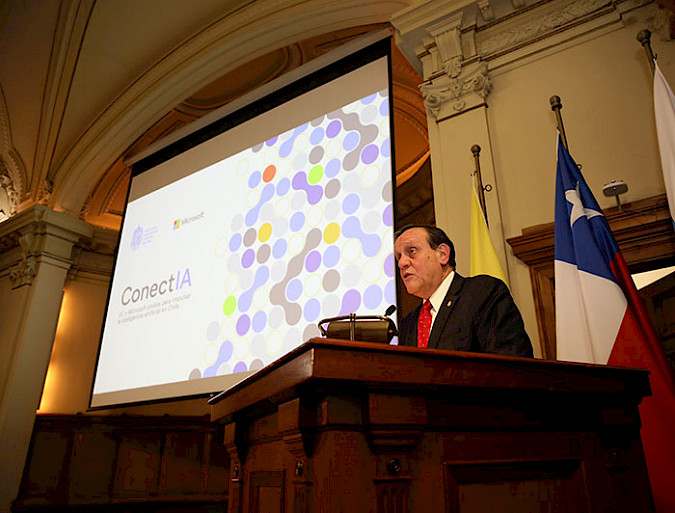
Digital transformation is one of the main axes of the UC Development Plan for 2020-2025. This process aims to enable people to interact directly with technology and data and to adopt a culture that leverages the benefits of this transformation. One of the challenges of this process is to increasingly integrate these technologies into teaching practices, research, and organizational management.
“As a university dedicated to societal impact and academic excellence, UC Chile cannot remain on the sidelines of this technological revolution but must be a regional leader in the development and research of artificial intelligence.” - Ignacio Sánchez, UC Chile President.
Share
According to UC Chile Provost Guillermo Marshall, who has been one of the main promoters of the ConectIA project, this initiative could also have a significant impact on education. "This partnership allows us to be protagonists and leaders of a technological revolution whose scope is difficult to measure today. It is very likely that this will imply, in the near future, reviewing the curricula, the teaching-learning processes, and the assessment methods for our students," he said.
“This partnership allows us to be protagonists and leaders of a technological revolution whose scope is difficult to measure today. It is very likely that this will imply, in the near future, reviewing the curricula, the teaching-learning processes, and the assessment methods for our students.” - Guillermo Marshall, UC Chile Provost.
Share
Incorporating AI into Educational Institutions
Bruce Thompson, Microsoft's Director of Education for the Americas and an expert in technological matters, spoke about how higher education institutions can efficiently take advantage of AI, sharing different examples and international initiatives. "AI is going to change the way students receive information, which creates an impact on the curriculum, on instructional design," he said.
For AI to reach its full potential, he stressed that it is important to unite institutional strategies with technology, which requires overcoming different challenges and incorporating cultural changes to facilitate the adoption of this technology. According to Thompson, it is essential to define concrete objectives in the incorporation of AI, as well as goals at the level of academic units and central entities of the university's administration.
“AI is going to change the way students receive information, which creates an impact on the curriculum, on instructional design.” - Bruce Thompson, Microsoft’s Director of Education for the Americas.
Share
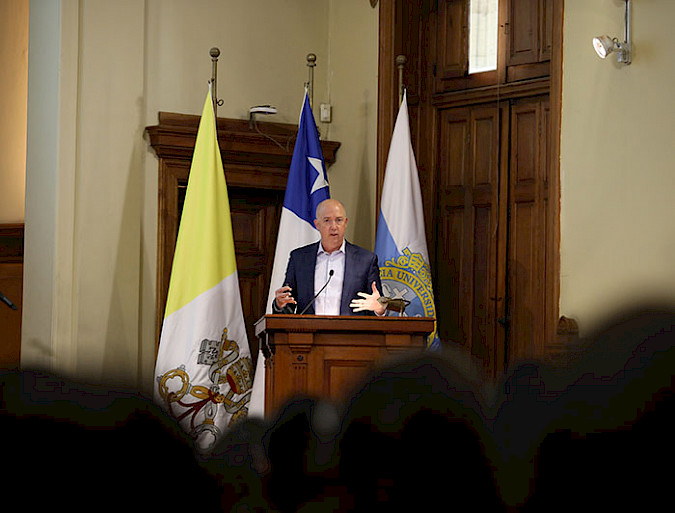
For the incorporation of AI within the university, Thompson emphasized the importance of providing guidelines and support to facilitate learning, such as teaching how to ask the right questions to get accurate answers from AI tools. He also highlighted hackathons as a way to promote AI adoption, where students use their programming skills to create solutions for specific challenges. He stated that UC Chile, through its leadership, can become a role model for Chile and the region by successfully incorporating these technologies.
The Microsoft expert shared several examples of how schools and universities in the United States had managed to reduce workloads through the use of AI. The New York City school system, which has 1.2 million schoolchildren, created a 'tutor-bot' that assists them. In the case of the University of Michigan, academics and researchers are supported by bots that help them do their research work faster and more efficiently. Meanwhile, Canada's Seneca Polytechnic has developed an AI-based job-finding service, making it easy for students to practice and conduct mock job interviews for selected companies.
"It is important for students and teachers to learn about AI and develop the skills to use it," said Bruce Thompson.
Partnership Progress
The first step in the creation of ConectIA was taken at the end of last year when UC Chile signed an agreement with Microsoft. The purpose of this collaboration is to "pioneer digital transformation through the integration of artificial intelligence, aiming to create a significant impact within the university and across Chile and the region."
According to María Francisca Yáñez, Director of Microsoft's National Technology Office, "the partnership is not only focused on technology and AI, but also on academic challenges, research, and educational experiences." Based on UC Chile's own challenges, the team outlined 31 initiatives to be worked on over the next five years.
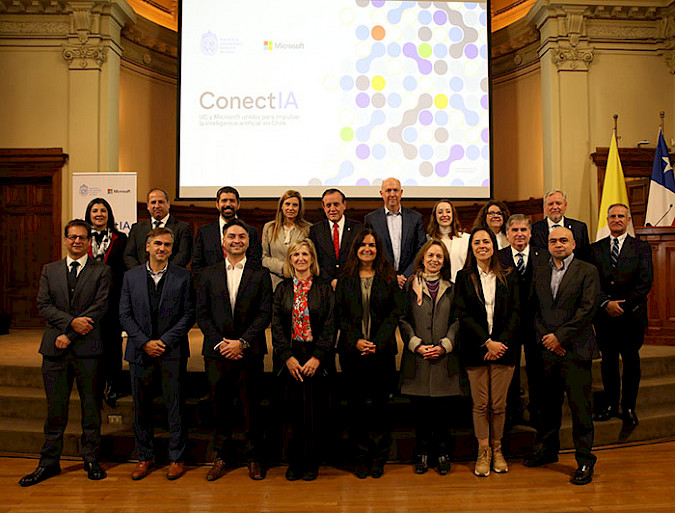
"One of the major challenges that companies and institutions face in adopting AI technologies is the lack of trained teams. Therefore, the university's role in advancing knowledge and training students and work teams is crucial," said Yáñez.
The ConectIA project was designed with the understanding that digital transformation and the implementation of technologies such as AI must be done in stages, and also with constant consideration of the university's mission and vision.
“One of the major challenges that companies and institutions face in adopting AI technologies is the lack of trained teams. Therefore, the university's role in advancing knowledge and training students and work teams is crucial.” - María Francisca Yáñez, Director of Microsoft's National Technology Office.
Share
Mauricio Bernabó, Director of UC Digital Transformation, announced some of the 31 initiatives that are being promoted in this phase of the partnership. One such initiative is the development of a chatbot that uses artificial intelligence to understand and answer questions in a human-like manner. "We are leveraging all the information the university has so we can ask the chatbot questions and receive quick answers. Our goal is to include all regulations, data related to academic units, programs, and other types of information. This will be very useful for everyone who can access it from different devices," explained Bernabó.
“We are doing several tests on how all of the university’s data that is on the internet can be used to do very fast analyses by program and faculty” - Mauricio Bernabó, Director of Digital Transformation.
Share
Copilot, an artificial intelligence system developed by Microsoft, is another tool already being used at the university, which provides up-to-date information to anyone connected to the internet. Among its various functions, it can be used to search for data, summarize conversations, request the creation of content, design images, like other platforms, such as ChatGPT.
A third initiative consists of using AI to take advantage of all the information available to the university, using reporting systems. “We are doing several tests on how all of the university’s data that is on the internet can be used to do very fast analyses by program and faculty,” said the Director of Digital Transformation, adding that all members of the university community are invited to be active participants in this partnership.
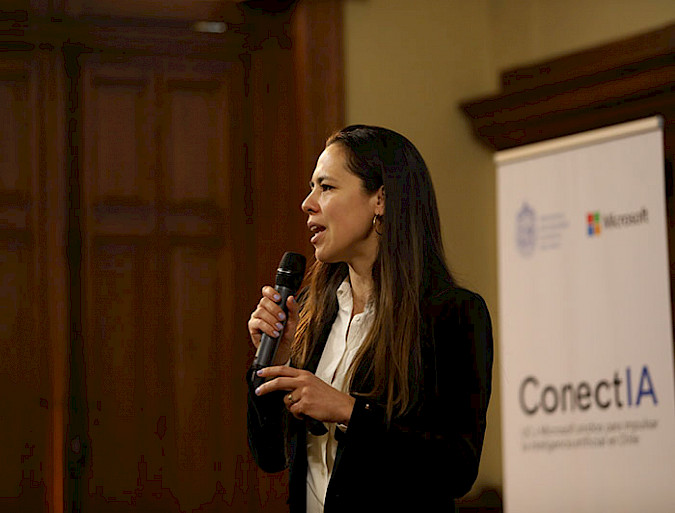
AI Online Learning
With the understanding that people are at the center of institutions and change processes, it was determined that providing access to AI learning tools is essential. This led to the creation of the AcademiaIA platform, which offers free access to Microsoft courses for the university community. Currently, 175 resources are available, including courses for beginners, intermediate, and advanced learners on basic AI concepts, responsible AI practices and principles, and deep learning models in software, among others.
According to Francisco Quiroga, UC's Deputy Director of Institutional Technologies, “The proposed goals include guaranteeing access to formal AI learning resources, creating events and collaborative spaces to promote the exchange of ideas and experiences with AI, and providing tools to facilitate the adoption of AI-based technologies in daily activities.”
AcademiaIA is aimed at the academic body, students, and the university's professional and administrative staff.
Various events will be organized in association with this platform. The next event is a talk on “How to Create Content with Generative AI," scheduled for May 23 at 15:00, presented by Sylvie Duchamp, Microsoft's Director of External Communications for South America. Additionally, a course and certification on Azure AI Fundamentals, another Microsoft platform, was recently launched.




